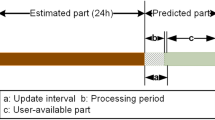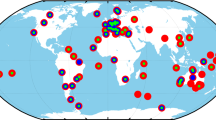Abstract
Accurate position, velocity, and acceleration information are critical for airborne gravimetry. In Antarctica, there is a sparse distribution of IGS stations, and the rough terrain makes it impractical to set up nearby reference stations. Therefore, traditional differential GPS techniques may be difficult to implement. Precise point positioning (PPP) is independent of reference stations and provides an unlimited operating distance. However, it is highly dependent on precise satellite orbit and clock information, and may be vulnerable to discontinuities of orbit or clock offsets. An extended PPP method, called precise orbit positioning (POP), is implemented towards multi-GNSS. This approach introduces a widely spaced network of stations and is independent of precise clock information, as it estimates satellite clock offsets and drifts “on-the-fly” and only relies on precise orbit information. The advantage of being independent of clock information is that the IGS ultra-rapid (predicted) products can be applied to real-time POP since the orbits can achieve an accuracy of about 5 cm. This becomes significant when applied to airborne gravimetry, as gravity results calculated from gravity measurements and GNSS solutions can be investigated in real time. By means of processing of 5 IGS stations over Antarctica, it turns out that the PPP solution is greatly affected by discontinuities of the IGS orbit and clock offsets at the day boundaries, accompanied with some biases as large as several decimeters in the vertical component. However, the POP solution remains robust and almost no large positioning errors appear, and the accuracy improves by about 50% in the north, east, and up coordinate components. The aircraft positions derived from relative positioning, PPP, and POP during the kinematic flight period generally agree at the decimeter level because of the lack of observed satellites with elevation angles higher than 60°. Nevertheless, the potential for POP to generate centimeter-level kinematic vertical positions over long baselines is illustrated. Moreover, the POP and double-difference derived velocities and accelerations agree with each other well in both static and kinematic flight periods. After a low-pass filter, the GNSS-based accelerations are of the order of 1 mgal and are considered useful for separating the disturbing kinematic accelerations from the gravity measurements.












Similar content being viewed by others
References
Cannon ME, Lachapelle G, Szarmes MC, Hebert JM, Keith J, Jokerst S (1997) DGPS kinematic carrier phase signal simulation analysis for precise velocity and position determination. J Inst Navig 44(2):231–246
Defraigne P, Bruyninx C, Guyennon N (2007) GLONASS and GPS PPP for time and frequency transfer. In: Proceedings of the EFTF 2007, Geneva, Switzerland, May 29–June 1, pp 909–913
Ge M, Gendt G, Rothacher M, Shi C, Liu J (2008) Resolution of GPS carrier phase ambiguities in precise point positioning (PPP) with daily observations. J Geodesy 82(7):389–399
Geng J, Shi C, Ge M, Dodson AH, Lou Y, Zhao Q, Liu J (2012) Improving the estimation of fractional-cycle biases for ambiguity resolution in precise point positioning. J Geodesy 86(8):579–589. https://doi.org/10.1007/s00190-011-0537-0
He K (2015) GNSS kinematic position and velocity determination for airborne gravimetry. Ph.D. thesis, Technische Universität Berlin, Berlin, 2015
He K, Xu G, Xu T, Flechtner F (2016) GNSS navigation and positioning for the GEOHALO experiment in Italy. GPS Solut 20(2):215–224
Jekeli C, Garcia R (1997) GPS phase accelerations for moving-base vector gravimetry. J Geodesy 71(10):630–639. https://doi.org/10.1007/s001900050130
Jiang N, Xu Y, Xu T, Xu G, Sun Z, Schuh H (2016) GPS/BDS short-term ISB modelling and prediction. GPS Solut 21(1):163–175. https://doi.org/10.1007/s10291-015-0513-x
Jordan T, Robinson C, Olesen A, Forsberg R, Matsuoka K (2016) PolarGap 2015/16: filling the GOCE polar gap in Antarctica and ASIRAS radar flight for CryoSat support. Data acquisition report. European Space Agency (ESA)
Kennedy S (2002) Precise acceleration determination from carrier phase measurements. In: Proceedings of ION GPS 2002, Institute of Navigation, Portland, USA, September 24–27, pp 962–972
Kouba J (2009) A guide to using international GNSS service (IGS) products. http://igscb.jpl.nasa.gov/igscb/resource/pubs/UsingIGSProductsVer21.pdf. Accessed May 2018
Kouba J, Heroux P (2001) Precise point positioning using IGS orbit and clock products. GPS Solut 5(2):12–28. https://doi.org/10.1007/PL00012883
Kreye C, Hein G (2003) GNSS based kinematic acceleration determination for airborne vector gravimetry—methods and results. In: Proceeding of ION GPS/GNSS 2003, Institute of Navigation, Portland, USA, September 9–12, pp 2679–2691
Leick A, Rapoport L, Tatarnikov D (2015) GPS satellite surveying, 4th edn. Wiley, Hoboken
Li X, Ge M, Dai X, Ren X, Fritsche M, Wickert J, Schuh H (2015) Accuracy and reliability of multi-GNSS real-time precise positioning: GPS, GLONASS, BeiDou, and Galileo. J Geodesy 89(6):607–635
Li M, He K, Xu T, Lu B (2018) Robust adaptive filter for shipborne kinematic positioning and velocity determination during the Baltic Sea experiment. GPS Solut 22:81. https://doi.org/10.1007/s10291-018-0747-5
Lu B, Barthelmes F, Petrovic S, Förste C, Flechtner F, Luo Z, He K, Li M (2017) Airborne gravimetry of GEOHALO mission: data processing and gravity field modeling. J Geophys Res Solid Earth 122:10586–10604. https://doi.org/10.1002/2017JB014425
Malys S, Jensen PA (1990) Geodetic point positioning with GPS carrier beat phase data from the CASA UNO experiment. Geophys Res Lett 17(5):651–654
Salazar D, Hernandez-Pajares M, Juan-Zornoza J, Sanz-Subirana J (2009) GNSS data management and processing with the GPSTk. GPS Solut 14(3):293–299. https://doi.org/10.1007/s10291-009-0149-9
Salazar D, Hernandez-Pajares M, Juan-Zornoza J, Sanz-Subirana J, Aragon-Angel A (2011) EVA: GPS-based extended velocity and acceleration determination. J Geodesy 85(6):329–340. https://doi.org/10.1007/s00190-010-0439-6
van Graas F, Soloviev A (2004) Precise velocity estimation using a stand-alone GPS receiver. Navigation 51(4):283–292
Wang J, Rizos C, Stewart MP, Leick A (2001) GPS and GLONASS integration: modeling and ambiguity resolution issues. GPS Solut 5(1):55–64
Wanninger L (2012) Carrier phase inter-frequency biases of GLONASS receivers. J Geodesy 86(2):139–148
Zhang X, Forsberg R (2007) Assessment of long-range kinematic GPS positioning errors by comparison with airborne laser altimetry and satellite altimetry. J Geodesy 81:201–211
Zhang X, Zheng K, Lu C, Wan J, Liu Z, Ren X (2017) Acceleration estimation using a single GPS receiver for airborne sclar gravimetry. Adv Space Res 60(10):2277–2288. https://doi.org/10.1016/j.asr.2017.08.038
Zheng K, Tang L (2016) Performance assessment of BDS and GPS/BDS velocity estimation with stand-alone receiver. J Navig 69(4):869–882. https://doi.org/10.1017/S0373463315000958
Zumberge JF, Heflin MB, Jefferson DC, Watkins MM, Webb FH (1997) Precise point positioning for the efficient and robust analysis of GPS data from large networks. J Geophys Res 102(B3):5005–5017. https://doi.org/10.1029/96JB03860
Acknowledgements
This study is supported by the Chinese Scholarship Council (no. 201506560002), the National Natural Science Foundation of China (Grant nos. 41574013, 41731069, 41874032, and 41604027), Qingdao National Laboratory for Marine Science and Technology (QNLM2016ORP0401), and the Shandong Provincial Natural Science Foundation (ZR2016DQ01). We are grateful to Dr. Maorong Ge and our colleagues in GFZ for their kind help, cooperation, and discussion. We are also very thankful to Fausto Ferraccilio from the British Antarctic Survey and René Forsberg from the Danish Technical University/National Space Institute for providing GNSS data from ESA’s PolarGAP campaign.
Author information
Authors and Affiliations
Corresponding author
Additional information
Publisher’s Note
Springer Nature remains neutral with regard to jurisdictional claims in published maps and institutional affiliations.
Rights and permissions
About this article
Cite this article
Li, M., Xu, T., Lu, B. et al. Multi-GNSS precise orbit positioning for airborne gravimetry over Antarctica. GPS Solut 23, 53 (2019). https://doi.org/10.1007/s10291-019-0848-9
Received:
Accepted:
Published:
DOI: https://doi.org/10.1007/s10291-019-0848-9




